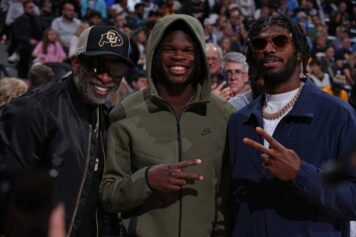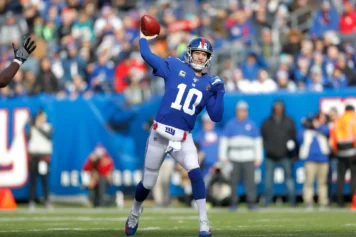Jacoby Jones was standing in the Baltimore Ravens’ end zone when he decided to run. It was the top of the third quarter and he had just caught a long kickoff from the Dallas Cowboys’ Dan Bailey that backpedaled him eight yards. Simultaneously, the throng of 71,384 fans scrummed into M&T Bank Stadium held their collective breath. In front of Jones were 11 Special Teams players barreling towards him with the momentum of fighting bulls unleashed from the bullpen in Pamplona. After surveying his spacing, Jones ran up the middle to the 10-yard line, untouched, jolting the crowd with electric anticipation. As he veered towards the right sideline, running like a rocket past defenders as if they were standing still, the stadium teetered on the brink of a sonic boom. He was at the 30. Run! He was at the 40. Run! He was at the 50. Run! He was at the 60! Ruuuuuunnnnnn! In an instant, Jones had sprinted 108 yards to the other end zone for the score, tying the record for the longest kickoff return in NFL history.
“We’ve been talking about getting a big play and breaking a play like that all year, and we have been close,” coach John Harbaugh said in the Ravens’ 31-29 victory over Dallas in mid October. “To set the National Football League record for a kickoff return, in what was the difference in the game, was pretty special.”
Electrifying plays like Jones’ record-setting kickoff return have no equal in NFL football. There’s no loss of inertia or tedious play-calling to advance the ball. It’s just a wide-open free-for-all where anything is possible. Anything can happen. It’s the one play that can break open any game and pump up the MF-ing volume.
It's also the one play that results in the most concussions. In light of all the controversial findings about retired NFL players suffering from mental illness or killing themselves while coping with brain damage resulting from head trauma sustained while playing football, NFL Commissioner Roger Goodell has brought up a proposal to the NFL competition committee to eliminate kickoffs completely.
"Whenever anything comes out of the Commissioner's office, I think it's appropriate to consider it serious," NFL executive vice president of football operations Ray Anderson told NFL.com. "But every year, the competition committee will look at several proposals to enhance player safety, and certainly the kickoff play, probably disproportionately our most dangerous play, gets attention every year like it did last year.”
Gone will be the traditional downfield booting of the ball to start the game. Gone will be the thrilling returns. Just like that, the signature play made famous by Deion “Primetime” Sanders will be discarded like Mitt Romney political buttons and relegated to dated highlight videos on YouTube. Gone. Dunzo. Finito.
Hold up, that also means there’ll be no more onside kicks, either, huh? How can they dead the unpredictability of the game? It’s almost like when the NCAA banned dunking from 1967 to 1976. Without kickoffs, it just won’t be the same game. Period.
————
Between 2007 and 2010, in the NFL, an average of 33.3 concussions was reported per season on kickoffs compared to an average of 12.8 concussions per season on punts.
The disparity lies in the different ways players line up for each play. During kickoffs, players build up speed like Usain coming down the field to block, tackle and obliterate. During punts, players are all at the line of scrimmage, virtually eliminating the opportunities for high-speed head crackin’.
To cut down on injuries, the NFL moved the kickoff line up five yards to the 35-yard line in 2011. According to Goodell & Co., concussions on kickoffs were down more than 40% last season as a result of the rule change.
Concussions weren’t always a top concern for America’s No. 1 game. For years, the NFL ignored the connect between head blows on the field and brain damage later in players’ lives. When Ann McKee, a School of Medicine associate professor of neurology and pathology at Boston University, discovered her first case of chronic traumatic encephalopathy (CTE) in a former professional football player, former Houston Oilers’ linebacker John Grimsley, it was thought that her findings would ruin football. But McKee, a diehard Green Bay Packers fan, vowed to do more than just dress down the NFL for its startling violence, she would find ways to make the game safer, too.
“What BU brought to the table was an explanation for some of the bizarre behavior we’d seen in a number of players whose lives were cut short, many because of suicide or what were thought to be accidental injuries,” says Kevin Guskiewicz, chair of the exercise and sport science department at the University of North Carolina and author of a 2003 study linking concussions in retired NFL players to clinical depression.
During the ’09-10 season, the NFL instituted new return-to-play guidelines that forced players diagnosed with a concussion to sit out the remainder of the game. Additionally, kickoffs were moved up to encourage more touchbacks and fewer high-speed collisions like the one that caused former Rutgers University player Eric LeGrand to suffer a severe spinal injury during a collision with kickoff returner Malcolm Brown.
That life-changing injury prompted then Rutgers coach Greg Schiano to suggest that instead of a team kicking off after a score, that team would get the ball on its own 30-yard line on fourth and 15. From there, the team could either go for it to try to retain possession or punt. The deterrent against teams going for it would be that if they fell short, the opposing team would take over with prime field position. So, more than likely, teams would opt to punt, thus replacing kickoffs and the apparent concussion dangers they incur.
"One of the things that when I was researching, I think it was like, in the old kickoff rules, 17 percent of the catastrophic injuries happened on kickoffs, yet it's only about 6 percent of the plays in the game," Schiano said. "Well, that is disproportionate. Things like that are the reasons that led me there, but obviously it's a personal thing with me because of Eric LeGrand."
————
Google changed everything. Now, parents and kids can research the long-term effects of concussions and it’s enough to make would be football players stiff-arm Pop Warner to opt for alternative sports that require a lot less contact during their formative years. Case in point: During an open forum with Robert Cantu and Christopher Nowinski, co-directors of BU’s Center for the Study of Traumatic Encephalopathy, readers were given an opportunity to ask about concussions in youth and adult sports and their effects on the brain.
“Are Pop Warner-aged children (13 and under) susceptible to these brain injuries as well?” a reader named Bob asked. “Are there equipment developments on the horizon to help this concussion issue? Would special mouth pieces help reduce the incidence of concussions?
“The brains of young children are considered to be the more sensitive to brain trauma than adults, so, yes, they are at risk,” Dr. Cantu answered. “The equipment industry, specifically helmet manufacturers, continues to make advances to protect against brain trauma. Currently, there is no evidence that mouth guards reduce the incidence or severity of concussion.”
Of course, Cantu took things too far when he suggested in his book, Concussions and Our Kids, that kids play touch football until they turn 14. Surprisingly, John Madden, whose very raison d’etre is NFL football, supports Cantu’s suggestion. Goodell doesn’t agree, but he was genuinely alarmed when five kids in Massachusetts suffered concussions in one game back in September.
This is why the NFL continues to funnel funds to organizations like BU to continue to research the effects of CTE and find out what steps can be taken to make the game he loves safer on all levels because, according to a recent study conducted by the Sports & Fitness Industry Association, the number of kids age 6 to 12 participating in tackle football had gone down 35% from 2007 to 2011.
That said, some three million tykes younger than 14 will still make a beeline to organized tackle football, proving that parents are concerned but still have love enough for the sport to allow their kids to crush, crash and bang on the field. This means the feeder system for the NFL is still very much intact. But should safety equipment cost more, what does that mean for the inner city youth? Does that create a barrier to entry? These are the questions to consider when instituting new equipment like more expensive helmets to protect those precious little noggins in the pursuit of safety.
Additionally, if the NFL does follow through with its dramatic rewrite of the game by 86-ing kickoffs, they damn well better make sure that what’s left of the game is exciting enough to keep and attract fans for years to come.
The NFL should just listen to the fans on this one. Don’t mess with kickoffs–it’s too vital to the game. The L should keep focusing on discouraging helmet-to-helmet contact and keep enforcing the return-to-play rule. Hell, even move up the line five more yards if that makes them feel better. But, for the love of God, don’t mess with kickoffs. Leave this one part of the game that still brings the sizzle. Leave the one play that makes everyone in his or her seat hover near the boiling point of exhilaration as they watch that runner find real estate to break for the end zone. Leave the kickoff in the game, because as great as that 108-yard return record is, it can still be broken by a yard.



